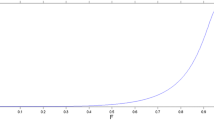Abstract
The problem of model indistinguishability is introduced in the context of linear compartmental models in pharmacokinetics. The two most widely used methods of analyzing model indistinguishability are described. It is shown that as the number of compartments increases, one approach, based on the Laplace transforms of the observations, although conceptually simple, can result in very large numbers of candidate models to be examined for indistinguishability, while the other approach, based on similarity transformations, although systematic, often results in very difficult algebraic expressions. These problems can be eased by the use of some simple geometrical rules, used at the outset of an indistinguishability analysis. The approach is illustrated by application to two 2-compartment drug, 2-compartment metabolite models.
Similar content being viewed by others
References
J. G. Wagner. Do you need a pharmacokinetic model and, if so, which one?J. Pharmacokin. Biopharm. 3:457–478 (1975).
J. P. Corfmat and A. S. Morse. Structurally controllable and structurally canonical systems.IEEE Trans. Autom. Control AC-21:129–131 (1976).
E. J. Davison. Connectability and structural controllability of composite systems.Automatica 13:109–123 (1977).
R. M. Zazworsky and H. K. Knudsen. Controllability and observability of linear time invariant compartmental modelsIEEE Trans. Automat. Control AC-23:872–877 (1978).
Y. Hayakawa, S. Hosoe, M. Hayashi, and M. Ito. On the structural controllability of compartmental systems.IEEE Trans. Autom. Control AC-29:17–24 (1984).
S. Vajda. Structural equivalence of linear systems and compartmental models.Math. Biosci. 55:39–64 (1981).
E. Walter.Identifiability of State Space Models. Lecture Notes in Biomathematics No. 46, Springer-Verlag, New York, 1982.
A. Venot, E. Walter, Y. Lecourtier, A. Raksanyi, and L. Chauvelot-Moachon. Structural identifiability of “first pass” models.J. Pharmacokin. Biopharm. 15:179–189 (1987).
M. J. Chapman and K. R. Godfrey. The problem of structural equivalence in biomedical system models.3rd IMEKO Conference on Measurement in Clinical Medicine, Edinburgh, September 1986, Institute of Measurement and Control, pp. 213–219.
Y. Lecourtier, E. Walter, and P. Bertrand. Methods for the study of unidentifiable state space models.Trans. Inst. Meas. Cont. 3:21–27 (1981).
E. Walter and Y. Lecourtier. Unidentifiable compartmental models: what to do?Math. Biosci. 56:1–25 (1981).
S. Vajda. Structural equivalence and exhaustive compartmental modeling.Math. Biosci. 69:57–75 (1984).
E. Walter, Y. Lecourtier, A. Raksanyi, and J. Happel. On the distinguishability of parametric models with different structures. In J. Eisenfeld and C. DeLisi (eds.),Mathematics and Computers in Biomedical Applications, Elsevier, Amsterdam, 1985, pp. 145–160.
A. Raksanyi, Y. Lecourtier, E. Walter, and A. Venot. Identifiability and distinguishability testing via computer algebra.Math. Biosci. 77:245–266 (1986).
E. Walter, Y. Lecourtier, J. Happel, and J.-Y. Kao. Identifiability and distinguishability of fundamental parameters in catalytic methanation.Am. Inst. Chem. Engrs. 32:1360–1366 (1986).
M. J. Chapman and K. R. Godfrey. On structural equivalence and identifiability constraint ordering. In E. Walter (ed.),Structural Identifiability of Parametric Models, Pergamon, New York, 1987, pp. 32–41.
M. Rowland, L. Z. Benet, and S. Riegelman. Two-compartment model for a drug and its metabolite: application to acetylsalicyclic acid pharmacokinetics.J. Pharm. Sci. 59:364–367 (1970).
M. Milanese and G. P. Molino. Structural identifiability of compartmental models and pathophysiological information from the kinetics of drugs.Math. Biosci. 26:175–190 (1975).
M. Milanese and G. Belforte. Structural problems in identification, state estimation and aggregation.Large Scale Syst. 2:97–104 (1981).
M. Gibaldi and D. Perrier.Pharmacokinetics, 1st ed. Marcel Dekker, New York, 1975, pp. 84–86.
M. Gibaldi and D. Perrier.Pharmacokinetics, 2nd ed. Marcel Dekker, New York, 1982, pp. 61–62.
H. G. Boxenbaum and S. Riegelman. Pharmacokinetics of isoniazid and some metabolites in man.J. Pharmacokin. Biopharm,4:287–325 (1976).
Author information
Authors and Affiliations
Rights and permissions
About this article
Cite this article
Godfrey, K.R., Chapman, M.J. The problem of model indistinguishability in pharmacokinetics. Journal of Pharmacokinetics and Biopharmaceutics 17, 229–267 (1989). https://doi.org/10.1007/BF01059030
Received:
Revised:
Published:
Issue Date:
DOI: https://doi.org/10.1007/BF01059030




